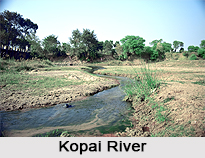 Kopai River is also known as the `Sal River` and is Mayurakshi River`s tributary, which flows across towns like Kankalitala, Bolpur and Shantiniketan and Labhpur in the district of Birbhum. This is based in the eastern Indian state of West Bengal. Kopai River is generally dry during summer but overflows during the rains, in monsoon.
Kopai River is also known as the `Sal River` and is Mayurakshi River`s tributary, which flows across towns like Kankalitala, Bolpur and Shantiniketan and Labhpur in the district of Birbhum. This is based in the eastern Indian state of West Bengal. Kopai River is generally dry during summer but overflows during the rains, in monsoon.
Soils of Kopai River
The region near Kopai River adjoining this river contains red soil where ravines are formed, and is popularly termed as the `khoai`. This beautiful river has been reputed for being the inspiration of several literary geniuses, which includes the noble laureate Rabindranath Tagore. One can recall the poem composed by Tagore which goes like this: `amader chhoto nodi chale anke bankey boisakh masey taar hantu jal thake, which when translated in English means, `Our small stream moves forward in bends and curves. In the month of Baisakh it only has knee deep waters`
Shape of Kopai River
Kopai River is shaped like a sickle, particularly its curves. It is this very charming appearance of this sickle-shaped Indian river which motivated Tarashanka Bandopadhyay to write a novel entitled `Hansuli Banker Upokatha` or `Story of the Sickle-Shaped Curve`. This novel was later made into a movie, by the famous film director Tapan Sinha.
History behind Kopai River
There are microliths of wood and crystalline stone belonging to the period of 1250 to 1000 BC have been discovered in the areas of Ajay -Kunar-Kopai river system. Kunur River is one of main tributaries of the Ajay River. It is about 112 kilometres in length. It has its origin near Bansgara in the Faridpur police station area. With water from several small streams swelling it during the monsoons, it often floods large areas of the Ausgram community blocks and Mangalkot police stations of Bardhaman district.















